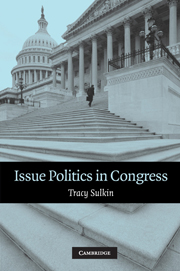Book contents
- Frontmatter
- Contents
- List of Figures
- List of Tables
- Acknowledgments
- Issue Politics in Congress
- 1 Electoral Challenges and Legislative Responsiveness
- 2 A Theory of Issue Uptake
- 3 The Nature of Campaign and Legislative Agendas
- 4 Assessing Uptake
- 5 Who Responds? Explaining Individual Variation in Uptake
- 6 Patterns of Responsiveness in Congress
- 7 The Electoral Impacts of Uptake
- 8 Uptake and Public Policy
- 9 Elections, Governance, and Representation
- Appendix: House and Senate Samples
- References
- Index
6 - Patterns of Responsiveness in Congress
Published online by Cambridge University Press: 08 January 2010
- Frontmatter
- Contents
- List of Figures
- List of Tables
- Acknowledgments
- Issue Politics in Congress
- 1 Electoral Challenges and Legislative Responsiveness
- 2 A Theory of Issue Uptake
- 3 The Nature of Campaign and Legislative Agendas
- 4 Assessing Uptake
- 5 Who Responds? Explaining Individual Variation in Uptake
- 6 Patterns of Responsiveness in Congress
- 7 The Electoral Impacts of Uptake
- 8 Uptake and Public Policy
- 9 Elections, Governance, and Representation
- Appendix: House and Senate Samples
- References
- Index
Summary
Having investigated the reasons for individual variation in uptake, the next step is to explore the broader contours of responsiveness across chambers, across legislative activities, and across time. These aggregate patterns run the risk of being obscured by the detail of the individual approach, but understanding their variation is crucial for assessing the potential contributions of an agenda-based model of responsiveness like uptake and for estimating its impact on legislative politics and public policy. As such, two questions lie at the heart of the analyses in this chapter. First, does uptake vary systematically in the manner predicted by the strategic motivation theory (i.e., Do representatives or senators exhibit more? Is uptake more prevalent on some activities than others? Do legislators spread their uptake behavior evenly across their terms, or is it concentrated at the beginning or end?). Second, do these patterns hold across all legislators or do choices about when and where to engage in uptake vary with factors like vulnerability?
Comparing Uptake Rates in the House and Senate
Beginning with variation across chambers, the prediction of the strategic motivation theory is that senators will exhibit higher levels of uptake than representatives. This expectation is, of course, at odds with the conventional wisdom on the subject, which assumes that members of the House of Representatives, having smaller constituencies and more frequent elections, will be more responsive. However, I have argued that there are a number of reasons why we should expect to observe higher levels of uptake in the Senate.
- Type
- Chapter
- Information
- Issue Politics in Congress , pp. 114 - 127Publisher: Cambridge University PressPrint publication year: 2005



